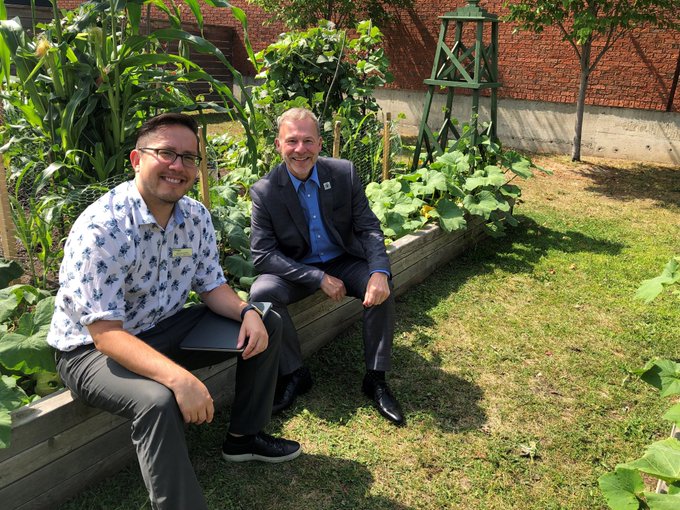Three Sisters Garden Returns with New Harvest
Posted on Monday, September 20th, 2021

Chef Russell Weir (far left); Chef Manuel Gomes; Jeff Turner, Partnership Development Specialist; Ron (Deganadus) McLester, Vice President – Truth, Reconciliation & Indigenization (far right); with the fall 2021 harvest from the College’s Three Sisters garden.
Algonquin College’s “Three Sisters” Indigenous garden returned this year and produced another rich fall harvest.
Horticultural Industries students originally planted the ceremonial garden of Corn, Beans and Squash in 2019. After going untended in 2020 due to the COVID-19 pandemic, the garden — located in the outdoor courtyard between E, H and D Buildings — was re-planted in the spring of 2021 and is being harvested this month.
The courtyard was used to grow vegetables and herbs for many years by the School of Hospitality and Tourism until its transformation into a traditional Haudenosaunee-style community garden. This thriving green space also gives people of other cultures access to the Haudenosaunee creation story, of which the Three Sisters are an important component.
In 2017, Ron (Deganadus) McLester, Vice President, Truth, Reconciliation & Indigenization, told College employees the significance of the Three Sisters story. “There are many stories about the Three Sisters in woodland Indigenous cultures. While the details of these stories differ from nation to nation, there is almost always one shared common thread that weaves them together. Today, we recognize Corn, Beans and Squash who have always worked together in order to sustain our communities. Today, we recognize that these Three Sisters are bound together by three tenets: peace, friendship and respect. Today, we recognize that these three tenets are what make the Sisters special.”
Each plant has a role in the health and prosperity of the garden. The corn is planted first in May. It provides a structure for the beans to grow on. The beans capture nitrogen from the air and release it into the soil as a nutrient for the other plants. The squash plants provide shade to the soil to keep it moist and cool, as well as shade out any weeds, and its prickly stems deter animals.
The corn grown in the Three Sisters Garden isn’t the conventional yellow or peaches-and-cream corn found in farmers markets and grocery stores. It is heirloom Haudenosaunee white corn, which requires special treatment to be rendered edible, and is most often used after preparation with beans and squash in a nourishing vegetable soup. The sharp-eyed visitor will also note that the corn is grown in mounds. In Haudenosaunee gardens, mounds are built to give the corn more room to spread its roots and to allow effective drainage.
The Three Sisters Garden is an extension of the large Indigenous garden planted in the DARE District’s Ishkodewan courtyard. That ongoing project will see more than 100 species of flowers, shrubs and trees planted — from black-eyed Susan and chokecherry to rosy sedge and yellowwood poppy. All of the plants are native to southern Ontario and many of them have cultural, ceremonial, or even medicinal significance for some Indigenous peoples.
Both garden projects reflect Algonquin’s ongoing commitment to embedding Indigenous traditions and knowledge in the College culture.
The Three Sisters Story
According to legends, Sky Woman, daughter of the Great Spirit, fell through a hole in the sky one day toward the vast expanse of blue water below. Sea creatures called upon the Turtle to come to the surface, and struggled to place earth found below the waters on his back. A flock of waterfowl guided Sky Woman down onto the Turtle and his back grew larger and larger until it became Turtle Island – what we know as North America today.
When Sky Woman fell, she was pregnant, and she eventually had a daughter, Tekawerahkwa or ‘Breath of the Wind’. Tekawerahkwa became pregnant in turn by the Western Wind, and gave birth to twin boys. The Good Twin had a natural birth. He did good things, had a good heart and a good mind. The Bad Twin, who had no good qualities, was born unnaturally through his mother’s side, resulting in her death.
Sky Woman buried her daughter in a mound of dirt using the new earth formed on Turtle Island. From that mound of earth where her daughter was buried grew three sacred plants: corn, beans and squash — the three sisters that are used as a gift from the Creator to nourish and sustain all the inhabitants of Turtle Island.

Ron (Deganadus) McLester, Vice President – Truth, Reconciliation & Indigenization and President Claude Brulé when the garden was originally planted in 2019.
- Posted in
- TRI News